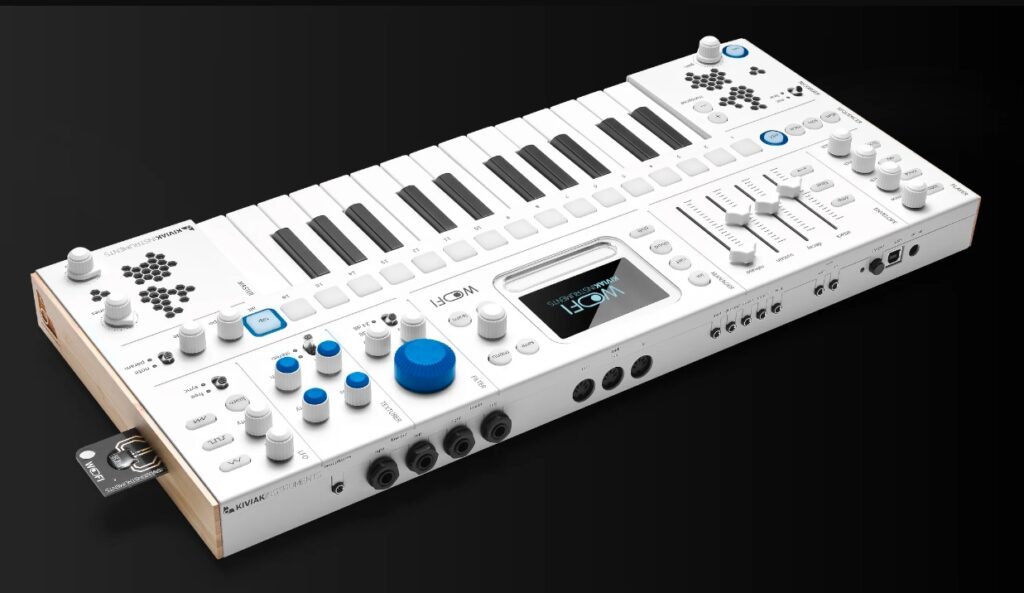A unique lo-fi sample-based synth with some clever social elements built in, the WoFi combines cloud technology and music seamlessly. Greg Scarth puts it to the test.

Lots of music tech brands are born out of the musical passions of people involved in other tech industries. That’s typically based on knowledge of electronics or manufacturing, but sometimes people transfer less common skills. Kiviak Instruments is an offshoot of Kiviak Technologies, a French IT and cloud service provider. Founder Romain Giannetti launched the sub-brand in 2018 with the intention of putting that knowledge to use via his hobby of electronic music. The Kiviak Instruments WoFi is the brand’s debut release, the culmination of a design process which began around six years ago, focusing on the idea of combining cloud tech with samplers and synths.
The WoFi is a stylish unit, housed in an all-white enclosure which gives it a contemporary feel. Fundamentally, it’s a sample-based keyboard, but the focus is very much on carrying out processing on those raw sounds. You can sample from the built-in mic or line inputs, or transfer samples from a computer, then manipulate your sounds using a combination of classic techniques including time stretching, low-resolution sampling engines and conventional synth features like filters, envelopes and LFOs.
The Texturer feature is the main focus in terms of reimagining sounds entirely, combining granular synthesis with shimmer reverb to take small chunks (‘granules’) of a sampled sound and resynthesise them into new timbres based on the harmonic content of the original. Everything about the process is made quite straightforward to understand, lending an immediacy to the WoFi which is sure to appeal to beginners as well as more experienced musicians looking for quick and effective results.

There are parallels here with the classic Casio SK-1, a very humble sampling keyboard from the mid-1980s which acted as an introduction to sampling for a lot of producers of a certain age. Sampling is now infinitely more accessible than anyone might have predicted back in the 80s when the technology was new and exclusive, but the WoFi certainly has things in common with the unique creative approach of the SK-1, particularly in terms of the way it encourages you to experiment and prioritise character over pristine sound quality. The WoFi is way more powerful than the SK-1, of course, but the lo-fi aspect of its design adds huge personality. The WoFi is at its best when you embrace that gritty, edgy element, creating crunchy drum sounds or low-res synth basslines.

In addition to the sound itself, the user-friendliness of the WoFi is a major selling point. The compact, two-octave design and simple 16-step sequencer available alongside the synth/sampling engine feels familiar at this point, with a similar approach being taken by lots of portable instruments. Likewise, cloud storage of presets, sharing with other users and online editing aren’t completely new ideas, but their integration with the WoFi via the free online ‘mywo.fi’ platform is a particularly good example of the approach. It’s a management and storage platform, wireless transfer system and editor in one, with the WoFi connecting directly via Wi-Fi. Your own presets can be tagged automatically using mywo.fi’s AI tools, or sorted and organised manually. The social element of mywo.fi is also nicely implemented, allowing you to stay completely private if you prefer, or engage with the online community by sharing sounds publicly, to groups or with individual friends.

At just over £600, the WoFi isn’t the cheapest synth around, but it’s priced where we’d expect for a boutique offering from a new brand. The most obvious alternative is probably the Sonicware Lofi-12 XT, a similarly retro sample-based instrument which leans more heavily into sequencing rather than granular synthesis. The Lofi-12 is a good chunk cheaper at just under £360, but of course you do miss out on the proper keyboard and all the mywo.fi features. Both are good options, but if you value the convenience of editing, storing and sharing your sounds wirelessly then the WoFi is a great solution.
Greg Scarth
More info/buy